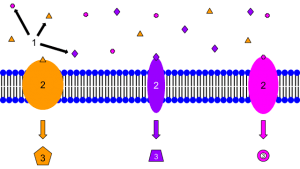Playlist
Show Playlist
Hide Playlist
Dipole-Dipole Interactions – Biological Interactions
-
Slides 10 Chemistry Advanced Le Gresley.pdf
-
Download Lecture Overview
00:01 Right. Now, let’s have a quick look at dipole-dipole interactions. If you look on the right hand side of the screen on the board, you’ll see here two carbonyl compounds. Indeed, we will call them ketones, in this particular case. As you recall, there is a slight positive charge conveyed by the electronegativity of the oxygen in the carbonyl-carbon position. 00:24 The electron density being pulled by the oxygen means there is a partial negative charge on the oxygen. 00:28 And what this results in is an interaction between the partial negative charge on the oxygen with the partial positive charge on a neighbouring ketone. And this is an example of a dipole-dipole interaction. And in many molecules, you’ll find that there are permanent dipoles due to the difference in electronegativities of atoms sharing chemical bonds. 00:50 Let’s have a look again at carbonyl groups. Note the delta positive on the carbon and the delta negative on the oxygen. This is the same not just for the carbonyl series, but bear in mind, also for things like amides, which contain carbonyl groups as well and also esters. 01:10 These dipoles, as I’ve said, will attract one another leading to bonds which are stronger than van der Waals. And this is an example of an electrostatic interaction. 01:22 Right. Let’s move on now to hydrogen bonds. 01:27 And these are special types of dipole-dipole interaction. And this occurs when you’ve got hydrogen directly bonded via a covalent bond to nitrogen, oxygen or sulphur. So, those are the three: nitrogen, oxygen or sulphur. And we haven’t talked much about sulphur and we’re not going to. We’re going to focus on nitrogen, in the case of amines, and oxygen, in the case of alcohols, and carboxylic acids. 01:52 As you can see from the diagram shown on the right hand side, we show an idealised system where the delta positive charge on the hydrogen from that dipole interacts strongly with the delta negative charge on the oxygen of a neighbouring water molecule. And here you have the argument of donor and receptor. 02:10 We consider something as an acceptor, if it is the electron-rich component in an interaction and we consider something as a donor, if it is the electron-weak part i.e. that which is accepting the electrons. 02:24 Two molecules of water are shown here and, due the difference in electronegativity between oxygen and hydrogen, the OH bond is, as we’ve said, polarised. The lone pairs of electrons on the oxygen bond with the hydrogen which has a partial positive charge. 02:40 Okay. The hydrogen is effectively shared between a donor and an acceptor in a hydrogen bond. 02:47 Which atom is it more tightly linked to though? Donors can form one hydrogen bond for each hydrogen. Acceptors, however, can form one hydrogen bond for each electron lone pair. 03:01 Hydrogen bonds are, therefore, directional. And so, the importance is not necessarily just the distance per se, but also the angle of attack. If you look at the bottom here, you’ll see there are two diagrams. One actually shows a hydrogen bonding of, in this case, a secondary amine with a ketone. As you can see, when the bonds are in line, when there is no need to change direction and the angle is 180 degrees over the top, you can see that that’s a reasonably strong hydrogen-bond interaction. However, when the orientation is not directly in line, you have a weak bond. So, these are the two examples of a strong and weak hydrogen bond. 03:43 Hydrogen bonds are important not only in terms of drug-target interactions, but as we’ve seen before, holding together the structure of both proteins and also DNA.
About the Lecture
The lecture Dipole-Dipole Interactions – Biological Interactions by Adam Le Gresley, PhD is from the course Medical Chemistry.
Included Quiz Questions
Which of the following is NOT true about dipole-dipole interactions?
- Dipole-dipole forces are weaker than van der Waal’s forces.
- Dipole-dipole forces are interactions between partially negative and partially positive ends of two polar molecules.
- Dipole-dipole interactions are electrostatic interactions.
- Dipole-dipole interactions are distance-dependent forces.
- Dipole-dipole forces are weaker than covalent bonds.
Why does water molecule have a permanent dipole in its molecular structure?
- Because H and O atoms have different electronegativity.
- Because H and O atoms have different atomic masses.
- Because H and O atoms have different number of electrons.
- Because H and O atoms have different number of protons.
- Because an O atom have a higher mass than a H atom.
Which of the following is NOT true regarding hydrogen bonds?
- Hydrogen bonds are weaker than van der Waal’s forces, but stronger than covalent bonds.
- Hydrogen bonds are a type of dipole-dipole interactions.
- Hydrogen bonds are directional- and distance-dependent.
- Hydrogen bonds play a critical role in stabilization of secondary and tertiary structures of proteins.
- Hydrogen bonds are important in pharmacological sciences as they play a major role in drug-target interactions.
Hydrogen bond angle determines which of the following?
- Strength of a hydrogen bond between two molecules.
- Geometry of a molecule acting as a donor in a hydrogen bond.
- Geometry of a molecule acting as a recipient in a hydrogen bond.
- Electronegativity of an atom participating in a hydrogen bond.
- Electronegativity of a H atom taking part in a hydrogen bond.
Customer reviews
5,0 of 5 stars
| 5 Stars |
|
5 |
| 4 Stars |
|
0 |
| 3 Stars |
|
0 |
| 2 Stars |
|
0 |
| 1 Star |
|
0 |




